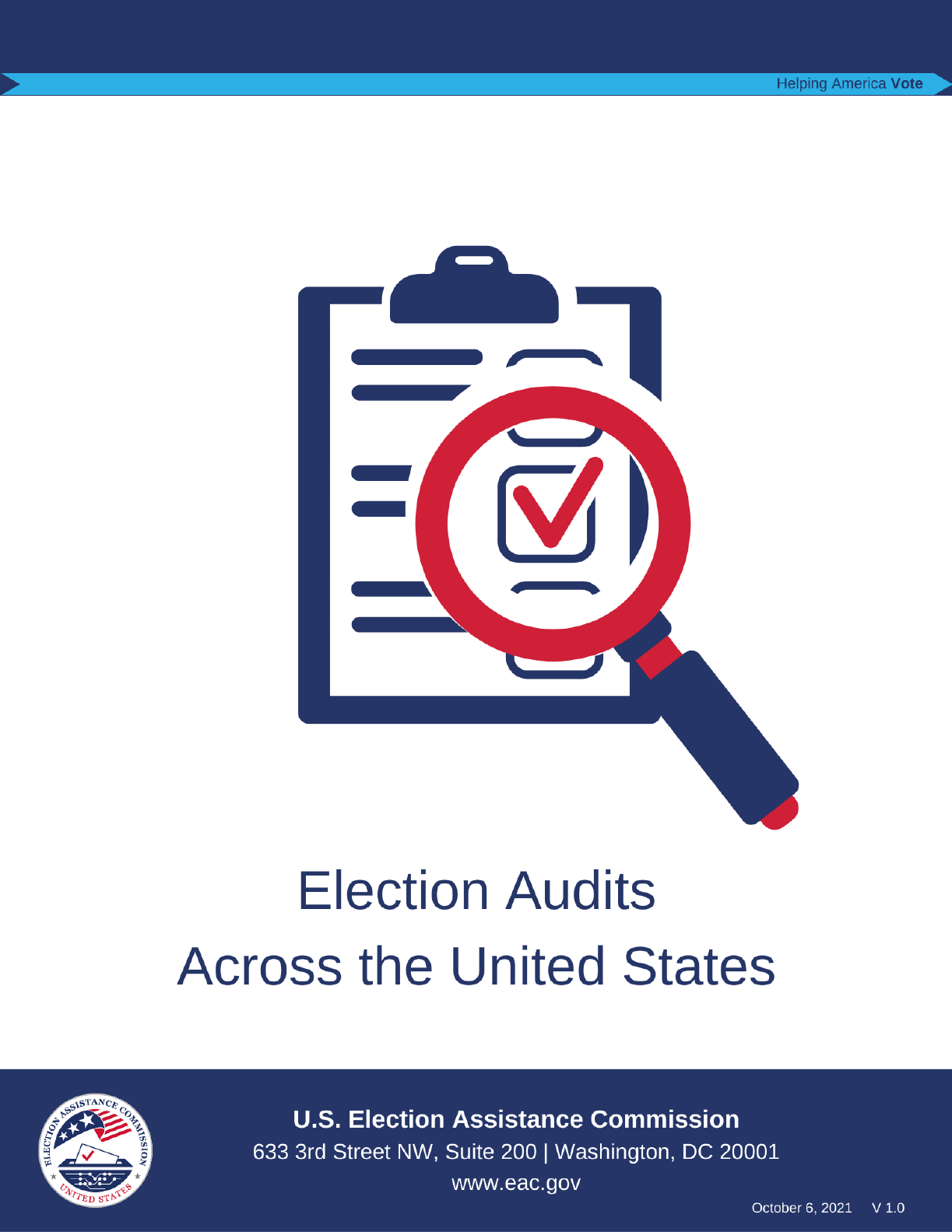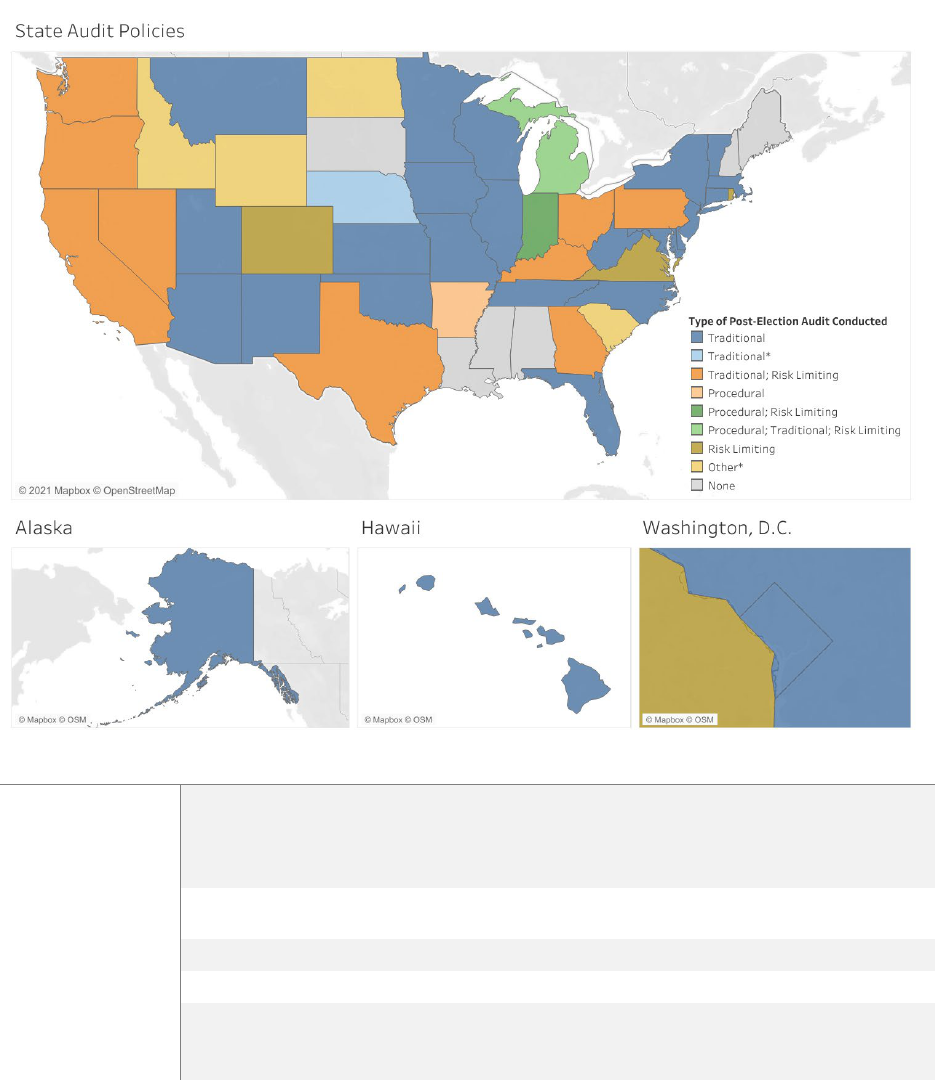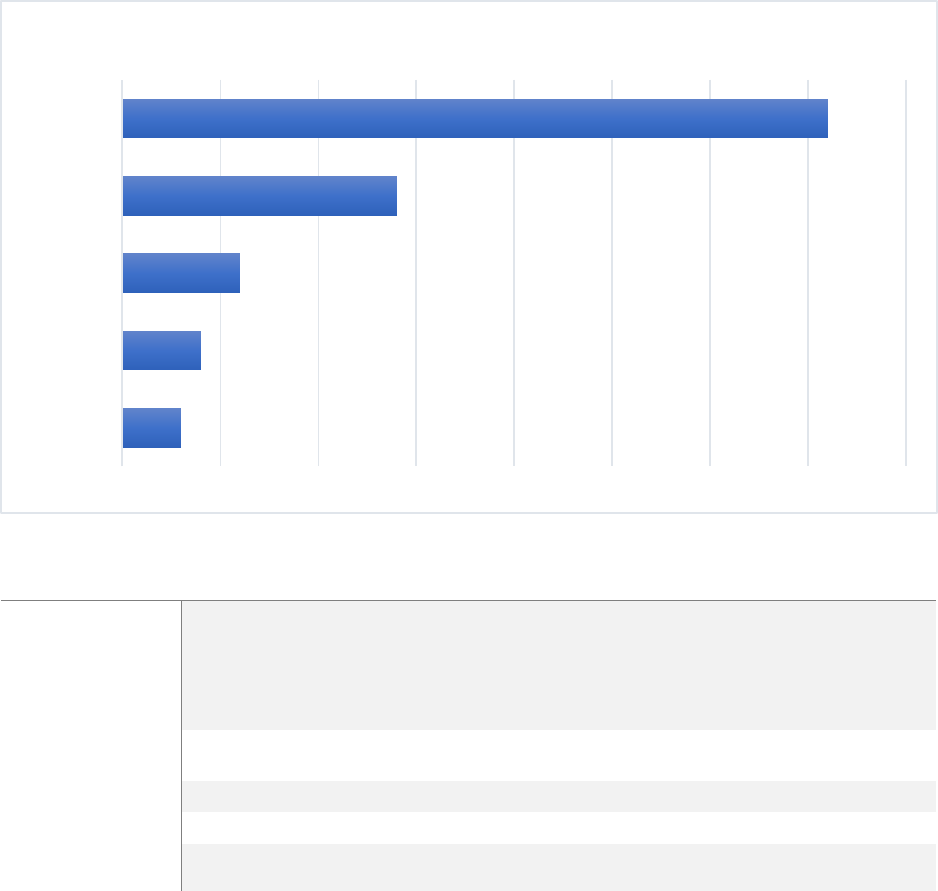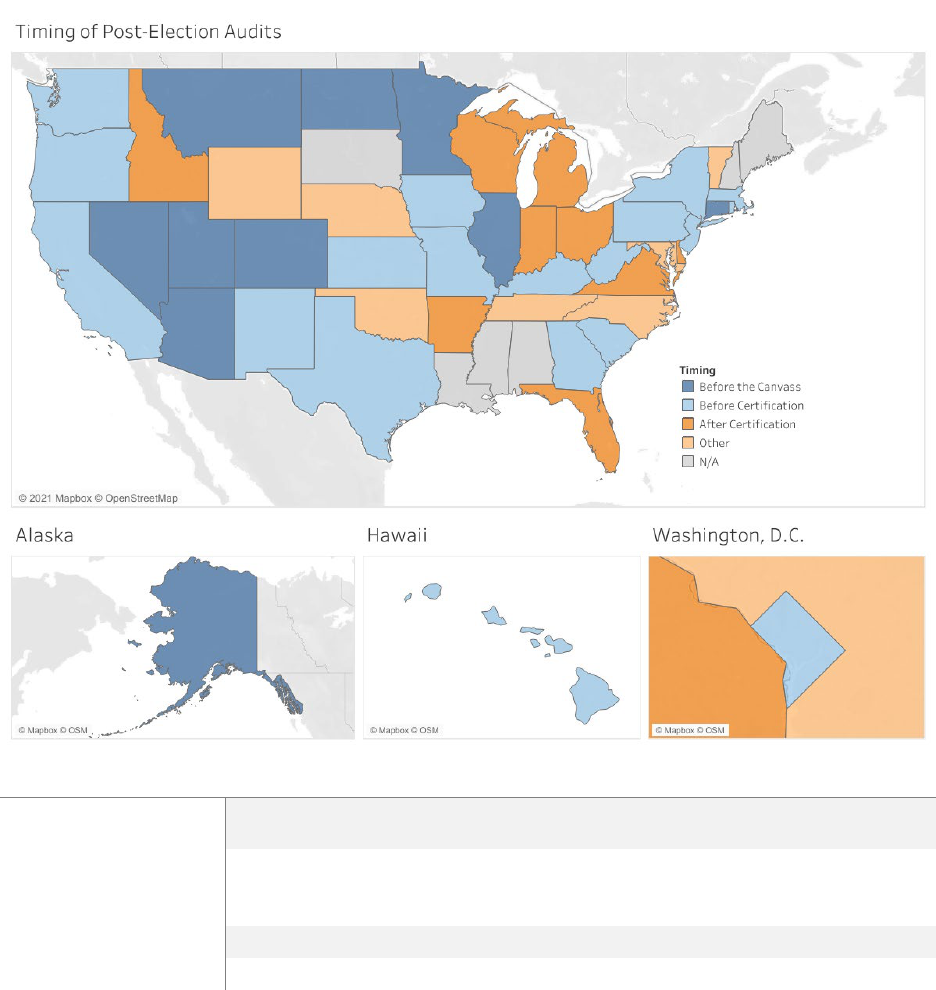
1

2
Contents
Introduction .......................................................................................................................................................... 3
Background ........................................................................................................................................................... 3
Post-Election Audit Overview ............................................................................................................................... 6
State Audit Policies ........................................................................................................................................... 7
Number of States with Post-Election Audit Laws in 2020 ................................................................................ 8
Timing of the Audit ........................................................................................................................................... 9
Traditional Audits ................................................................................................................................................ 10
Fixed Percentage Audits ................................................................................................................................. 10
Sample Sizes ................................................................................................................................................... 10
Contests Included ........................................................................................................................................... 12
Automated Audits ........................................................................................................................................... 13
Risk-Limiting Audits............................................................................................................................................. 15
Ballot Polling Audits ........................................................................................................................................ 15
Ballot-level Comparison Audits ...................................................................................................................... 16
Batch-level Comparison .................................................................................................................................. 17
Multiple Jurisdictions, Alternative Voting Methods, & Privacy ...................................................................... 17
Other Types of Post-Election Audits ................................................................................................................... 18
Tiered Audits ................................................................................................................................................... 18
Bayesian Audits ............................................................................................................................................... 18
Independent Audits ........................................................................................................................................ 19
Procedural Audits ........................................................................................................................................... 20
Project Management Planning ........................................................................................................................... 21
Training ............................................................................................................................................................... 22
Voting Systems.................................................................................................................................................... 22
Security ............................................................................................................................................................... 23
Transparency ...................................................................................................................................................... 24
Legal Considerations ........................................................................................................................................... 24
Federal law ..................................................................................................................................................... 24
State Law ........................................................................................................................................................ 25
Conclusion ........................................................................................................................................................... 26
Additional Resources .......................................................................................................................................... 26

3
Introduction
Election audits ensure voting systems operate accurately, that election officials comply with regulations or
internal policies, and identify and resolve discrepancies in an effort to promote voter confidence in the
election administration process. There is no national auditing standard, and methods can vary
from procedural, traditional, risk-limiting, tiered, or a combination of one or more types.
Interest in post-election audits has risen amongst the public, researchers, and policymakers in recent years.
In 2021, state lawmakers have introduced over 68 post-election audit bills in 29 states. At the time of
publication, at least nine have been signed into law.
Post-election audits are an essential component of the electoral process. This document provides
comprehensive information about election audits in the United States.
Background
The United States is unique among world democracies. There is no uniform election system under a
centralized election authority governing how elections are administered. Instead, elections are managed by
over 8,000 local governments, with unique rules and laws adopted by individual states.
Voting methods have changed significantly throughout the history of America, from voice voting to modern
computerized voting systems. Before the widespread use of voting systems, ballots were primarily cast in-
person on Election Day and counted by hand at the close of the polls on election night. Vote automation
began with lever machines in the late 19
th
-century, and by the 1960s, voting technology had progressed to
include punch cards and optical scanners. In 1965, California became one of the first states to require post-
election tabulation audits. The law required election officials to hand count ballots in one percent of
precincts that used a voting system to tally election results. The results of the hand count were then
compared with the results of the machine count, to verify the scanners counted ballots accurately. As more
jurisdictions began using modern voting technologies to count ballots, routine post-election audits gradually
expanded. However, states would not widely adopt the practice for another 50 years.
Congress passed the Help America Vote Act of 2002 (HAVA) when weaknesses of the punch card voting
system were demonstrated during the recount of the 2000 Presidential election. HAVA appropriated more
than $3.1 billion for the newly formed U.S. Election Assistance Commission (EAC) to distribute to states to
improve election administration, including purchasing new voting systems. Consequently, over the next
decade there was a move away from paper-based and punch card voting systems and widespread adoption
of electronic voting machines.
In 2005, the Commission on Federal Election Reform, commonly known as the Carter-Baker Commission, was
formed to recommend ways to raise confidence in the U.S. electoral system.
1
In its final report, the
Commission recommended that state and local election authorities publicly audit voting machines before,
during and after Election Day, to strengthen public confidence in the accuracy of machine tallies. In 2013,
President Obama issued an Executive Order establishing the Presidential Commission on Election
Administration (PCEA). The mission of the PCEA was to identify best practices and make recommendations to
1
Building Confidence in U.S. Election, Report of the Commission on Federal Election Reform, page 28:
https://www.legislationline.org/download/id/1472/file/3b50795b2d0374cbef5c29766256.pdf

4
improve the voting experience. In its final report, the PCEA recommended that all jurisdictions audit their
election machinery following each election. The PCEA endorsed both risk-limiting audits and performance
audits.
2
At that time, the most widely deployed technology across the United States was Direct-Recording
Electronic Devices (DREs) without a Voter Verified Paper Audit Trail (VVPAT),
3
and less than half of states (23)
were conducting post-election audits.
As security experts raised concerns about vulnerabilities in paperless voting systems, more jurisdictions
moved away from DREs back to voting systems that use hand-marked paper ballots or paper ballot back-ups.
By 2018, according to the Election Administration and Voting Survey (EAVS), less than two percent of election
jurisdictions were using DREs without VVPATs.
4
This was also the first year EAVS contained comprehensive
data about post-election audits in its final report. The report showed that by 2018 thirty-eight states required
a post-election audit.
5
By 2020, just 32 jurisdictions (0.5%) reported using DREs without VVPATs and nearly 80% (44) of states
required a post-election tabulation audit to verify voting equipment used during an election correctly counts
votes. Some states like Arkansas and Michigan require an audit of election procedures. Other states like
North Dakota require an audit of its voting devices. Even when not required by law, some states like Missouri
and Nebraska conduct an audit by a formal administrative rule or guidance. Other states like Louisiana do not
statutorily require audits, but audits are conducted in all parishes.
6
Although the majority of states are conducting post-election audits, there is no national standard for how
post-election audits should be structured. In August 2021, the National Association of Secretaries of State
(NASS) issued the first of its kind national recommendations for post-election audits.
7
The following are the
recommendations from the NASS Task Force on Vote Verification pertaining to post-election audits:
• States should have a requirement and timeframe, ideally in state statute, for post-election audits in
place prior to an election. These defined requirements should include conducting the audit as soon
as reasonably possible after an election, as well as a process to recertify election results based on the
results of the audit.
• Ensuring chain of custody procedures throughout the post-election audit process is paramount.
Election officials should be able to track the movement and transport of ballots, voting machines,
and other election materials through witnesses, signature logs, security seals, video, etc. A break in
the chain of custody increases the risk that the integrity or reliability of the asset cannot be restored.
The EAC Chain of Custody Best Practices document and
CISA Chain of Custody and Critical
Infrastructure Systems document should be used as a reference when establishing these procedures.
2
Presidential Commission on Election Administration Final Report, page 66:
https://www.eac.gov/sites/default/files/eac_assets/1/6/Amer-Voting-Exper-final-draft-01-09-14-508.pdf
3
2014 EAVS Report, page 14 :
https://www.eac.gov/sites/default/files/eac_assets/1/1/2014_EAC_EAVS_Comprehensive_Report_508_Compliant
.pdf
4
2018 EAVS Report, page 21: https://www.eac.gov/sites/default/files/eac_assets/1/6/2018_EAVS_Report.pdf
5
2018 EAVS Report, page 22: https://www.eac.gov/sites/default/files/eac_assets/1/6/2018_EAVS_Report.pdf
6
2020 EAVS Report, Executive Summary:
https://www.eac.gov/sites/default/files/document_library/files/2020_EAVS_Report_Final_508c.pdf
7
See: https://www.nass.org/sites/default/files/Summer 2021/NASS Vote Verification Task Force
Recommendations.pdf (accessed 10/6/2021)

5
• Have state and/or local election officials be an integral part of the post-election audit process,
including in the selection of the precincts or equipment to be audited. The involvement of any third-
party entities, such as a CPA firm, should be determined by the Chief State Election Official or state
legislative act prior to an election, and those entities must work closely with election officials.
• The post-election audit methods and processes must be transparent. This includes identifying who
may observe the audit, which should include members of the public, media, political party and/or
candidate representatives. Once the results of the post-election audit are completed and certified,
they should be made publicly accessible consistent with state law.
• To avert the possibility of voting systems becoming unusable, states should have criteria in place
prior to an election for the use of a federally or a state accredited test lab to perform any audit of
voting machine hardware or software.
• States should make every effort to educate the public on their post-election audit process, as well as
other processes and procedures in place to ensure the accuracy and public trust of the results.
Although NASS issued recommendations for conducting post-election audits, there is no consensus among
election administrators or policy makers on a single audit method. As a result, state and local election
officials use a variety of methods to conduct post-election tabulation audits based on different laws,
resources, and types of voting systems.
Since its formation, the EAC has supported innovating and improving the auditability of elections. The EAC
has made grant awards totaling over $1,463,074 to county and state organizations to support research,
development, documentation, and dissemination of a range of procedures and processes for managing and
conducting high-quality pre-election audits, logic and accuracy testing and post-election audit activities.
The EAC is also charged with developing Voluntary Voting System Guidelines (VVSG) and maintains a testing
and certification program to address how voters interact with voting systems and how voting systems are
designed and developed. In February 2021, the EAC adopted VVSG 2.0,
8
which recognizes the importance of
future election equipment’s ability to support efficient post-election tabulation audits and established a new
requirement of software independence. A voting system is software-independent if an undetected change or
error in its software cannot cause an undetectable change or error in an election outcome.
9
EAC developed and adopted VVSG 2.0 to meet the challenges ahead, to replace decade’s old voting
machines, to improve the voter experience, and provide necessary safeguards to protect the integrity of the
voting process, including enhancing the auditability of voting systems. All new voting systems certified to
VVSG 2.0 will ensure votes are marked, verified, and cast as intended, and that the final count represents the
true will of the voters. To ensure integrity of the voting process, new auditability methods were developed to
detect errors through the combined use of an evidence trail and regular audits.
The ultimate goal of verifying the accuracy and integrity of elections is the same in all jurisdictions, regardless
of the type of post-election audit utilized.
8
VVSG 2.0
https://www.eac.gov/sites/default/files/TestingCertification/Voluntary_Voting_System_Guidelines_Version_2_0.p
df
9
Rivest and Wack, On the notion of “software-independence” in voting systems, MIT and NIST, 2006.

6
Post-Election Audit Overview
In 2008, the EAC began collecting comprehensive data about post-election audits through Statutory Overview
and Policy surveys as part of the data collection for the biennial EAVS. The chart below shows which states
reported that a post-election audit was required in each reporting year.
10
Year
States
2008
Alaska, Arizona, Arkansas, California, Colorado, Connecticut, District of Columbia, Florida,
Illinois, Maryland, Minnesota, Missouri, Nevada, New York, North Carolina, North
Dakota, Oregon, Pennsylvania, Texas, Utah, Washington, West Virginia, Wisconsin
2010
+Delaware, Hawaii, Montana, New Mexico, Ohio, Tennessee, Wyoming
2012
+Nebraska
2014
+South Carolina, Vermont
2016
+Massachusetts
2018
+Iowa, Kentucky, Rhode Island
2020
+Georgia, Idaho, Indiana, Kansas, Michigan, New Jersey, Oklahoma
10
Throughout this document, the District of Columbia is included when referring to the states. Information on
post-election audits in the five U.S. territories (American Samoa, Guam, the Northern Mariana Islands, Puerto Rico,
and the U.S. Virgin Islands) was not submitted in EAVS data in all reporting years, and therefore is not included in
this document.
0
5
10
15
20
25
30
35
40
45
50
2008 2010 2012 2014 2016 2018 2020
States with Post-Election Tabulation Audits

7
State Audit Policies
Post-election audit methods vary by election. The map below shows audit methods that were either required
or optional by state law in 2020. Some states also implemented additional RLA pilot programs, although it
was not mandated by statute.
State
Other & Traditional*
Idaho
*A post-election audit is only conducted when a recount is required. For federal and
statewide office - 2% of the ballots cast in each county. For all other offices or
measure - 100 or 5% of ballots cast. Requirements escalate depending on the margin
of results.
South Carolina
*The audit process compares the tabulated results of the election with the raw data
collected in the electronic audit files by each voting machine on a flashcard.
Nebraska
*Not required by statute.
North Dakota
*1% of voting system programming in each county in the state.
Wyoming
*The pre-election logic and accuracy testing is repeated after the election. A random
audit of ballots is conducted by processing the pre-audited group of test ballots on
5% of the automated tabulating machines for that county.

8
Number of States with Post-Election Audit Laws in 2020
States use a variety of post-election audit methods, including procedural, traditional, risk-limiting audits
(RLAs) or a combination thereof. Some jurisdictions conduct post-election audits, even when not required.
Audit Type
States
Traditional
Alaska, Arizona, California, Connecticut, Delaware, District of Columbia, Florida,
Georgia, Hawaii, Illinois, Iowa, Kansas, Kentucky, Maryland, Massachusetts, Michigan,
Minnesota, Missouri, Montana, Nebraska, Nevada, New Jersey, New Mexico, New
York, North Carolina, Ohio, Oklahoma, Oregon, Pennsylvania, Tennessee, Texas, Utah,
Vermont, Washington, West Virginia, Wisconsin
Risk Limiting
California, Colorado, Georgia, Indiana, Kentucky, Michigan, Nevada, Ohio, Oregon,
Pennsylvania, Rhode Island, Texas, Virginia, Washington
None
Alabama, Louisiana, Maine, Mississippi, New Hampshire, South Dakota
Other
Idaho, North Dakota, South Carolina, Wyoming
Procedural
Arkansas, Indiana, Michigan
3
4
6
14
36
0 5 10 15 20 25 30 35 40
Procedural
Other
None
Risk Limiting
Traditional
Number of States with Post-Election Audit Laws in 2020

9
Timing of the Audit
The timing of post-election audits also differs among states. Some states require audits to be completed
before certifying final election results, either before beginning the canvass and prior to the certification
deadline. Other states require election audits after final results have been certified.
Timing
States
Before the Canvass
Alaska, Arizona, Colorado, Connecticut, Illinois, Minnesota, Montana, Nevada,
North Dakota, Utah
Before Certification
California, District of Columbia, Georgia, Hawaii, Iowa, Kansas, Kentucky,
Massachusetts, Missouri, New Jersey, New Mexico, New York, Oregon,
Pennsylvania, Rhode Island, South Carolina, Texas, Washington, West Virginia
After Certification
Arkansas, Delaware, Florida, Idaho, Indiana, Michigan, Ohio, Virginia, Wisconsin
Other
Maryland, Nebraska, North Carolina, Oklahoma, Tennessee, Vermont, Wyoming

10
Traditional Audits
Traditional audits look at a pre-determined number of ballots, voting precincts, or devices and compare
reported results from voting systems to the paper ballot records. State rules or laws determine who conducts
the audit, when the audit occurs, the methodology, and scope.
Fixed Percentage Audits
The most common type of post-election audit is one based on a percentage of precincts. The second most
common type requires a local election official to audit a number or percentage of voting devices. Some states
require a percentage of ballots to be audited. Required percentages range from 1% - 10% or could be
determined for each election by state election officials. In general, a state’s chief election official, an
independent audit board, or local election official randomly selects the precincts, devices, or ballots subject
to the audit, according to a pre-determined formula. A state may determine if all contests or only specific
contests on a ballot need to be recounted.
Once the specific ballots have been identified, an audit board tabulates the selected ballots, and the results
are compared to the reports issued from the voting system. If there is a discrepancy between the two, a state
may require additional ballots to be audited. The audit is considered complete if there are minimal or no
discrepancies, and election officials are satisfied that voting systems accurately tabulated ballots.
Sample Sizes
A variety of methods are used to determine audit sample sizes for traditional audits. Most states that use
traditional post-election audit methods can be broadly categorized as follows:
• Fixed Percentage Determined by State Law. These states will have the minimum percentage of
precincts, devices, or ballots set by statute and will not change unless state law is amended.
• Determined by State Election Official. In these states the chief election official is responsible for
determining the post-election audit procedures.
• Variable or Variable Fixed Percentage. These states will usually have either a fixed percentage that
varies with population size or some other formula. For example, Montana requires an audit of at
least 5% of the precincts in each county or a minimum of one precinct in each county, whichever is
greater; and the audit must include an election for one federal office, one statewide office, one
legislative office, and one ballot issue.
• Fixed Number of Precincts. These states have set a fixed number of precincts to be audited, instead
of a percentage of precincts. For example, Delaware requires an audit of all results of one election
district in each county and one election district in the city of Wilmington. A second option is to
randomly select a statewide race in one election district in each county and one election district in
the City of Wilmington.
• Other. These states will either have a fixed percentage of ballots cast, a minimum number of ballots
required to be audited, or another post-election requirement unique to the state. An example is
Pennsylvania which requires an audit of either 2% of ballots cast in each county or 2,000 ballots,
whichever is less. This category also includes states with different auditing requirements based on
the type of ballots cast (e.g., early voting or by mail) or depending on the type of election.

11
Many jurisdictions will audit more than the minimum percentage required. This could either be by the
discretion of election officials, triggered by contest margins or the percentage of precincts or devices in
smaller jurisdictions will be statically higher than the minimum required. For example, if a county only has 20
precincts and is required to audit 1% of them, it would be statistically equivalent to auditing 5% of precincts.
The map below displays the different types of audits based on the percentage of precincts within these broad
categories, but there are nuances in how every state selects sample sizes.
State
Other
Alaska
*1% from each Congressional district that accounts for at least 5% of ballots cast.
Arizona
*2% of precincts or two precincts/vote centers, whichever is greater for regular
ballots. 1% of ballots cast or 5,000 ballots, whichever is less, and up to 400 ballots for
each machine, including at least one accessible device, for early ballots.
Maryland
*At least 1% of ballot cast.
Pennsylvania
*2% of ballots cast in each county or 2,000 ballots, whichever is less.
Utah
*Vote-by-mail counties audit 1% or 1,000 mail ballots, whichever is less. Batches to
be audited are randomly selected by the Lt. Governor’s Office (LGO). One accessible
voting machine per 100 deployed in every Utah Congressional district, selected
randomly by the LGO, is audited.

12
Contests Included
The contests included in traditional post-election audits vary widely, with most states using unique
methodologies. The most common method requires auditing some statewide contests and at least one other
type of contest, such as a local office or ballot measure. The second most common method is for election
officials to audit every contest on the ballots selected for the audit. Iowa and Tennessee require an audit of
the Presidential or gubernatorial contest, depending on which race is on the ballot. Variations include
combinations of federal, statewide, and local contests, a minimum number of races, or vary with the type of
election.
Contests included in the Audit
State
Statute does not specify
Alaska, Arkansas, Kentucky, Maryland, Oklahoma,
Virginia
Some statewide and some other
contests are audited
Arizona, Colorado, Connecticut, Delaware, District of
Columbia, Florida, Hawaii, Idaho, Illinois, Kansas,
Massachusetts, Michigan, Minnesota, Missouri,
Montana, Nebraska, New Jersey, North Carolina, Ohio,
Oregon, Rhode Island, Texas, Washington
All statewide contests are eligible to be
audited, but no other contests
Georgia, New Mexico, Wisconsin
Pre-specified statewide contests are
audited
Iowa, Tennessee
Every contest and ballot issue on the
ballot is audited
California, Indiana, Nevada, New York, Pennsylvania,
Utah, Vermont, West Virginia
0 5 10 15 20 25
Every contest and ballot issue on the ballot is audited
Pre-specified statewide contests are audited
All statewide contests are eligible to be audited, but no
other contests
Some statewide and some other contests are audited
Statute does not specify
Contests Included in the Audit

13
Automated Audits
Traditional post-election audits are usually conducted by hand tallying a sample of paper records and
comparing the results to electronic reports produced by voting systems. However, hand counting can be
expensive, time-consuming, error prone, labor-intensive. To create efficiencies in the process, some states
allow the audit to be conducted electronically. For example, in Hawaii, the chief election official and a
bipartisan team have the option to retabulate 10% of precincts with their voting system as a part of their
post-election audit.
Another type of machine-assisted audit is known as a transitive audit. Transitive audits digitally scan the
ballots using a different voting system or tabulator, other than the primary voting system and compare the
two systems’ results. If both systems report the same winner(s), it provides evidence that the outcome is
correct, even if there are some discrepancies. For example, Florida election officials have the option to
conduct an independent automated audit, which involves using independent hardware and software
technology to tally votes cast across every race that appears on ballots in at least 20% of precincts chosen
randomly.
Below is an example of how automated software visually displays ballots with an undervote, overvote to
review voter intent and identify poorly marked ballots not tabulated.
11
. This also serves the dual purpose of
improving training for election officials to instruct voters on how to properly mark their ballots and helping to
identify tabulators that may need to be adjusted or cleaned if the images are crooked or misreading voter
intent.
11

14
Although automated audits can reduce costs and improve the efficiency of post-election audits, there are
important factors election officials consider when using this audit method. Using the same equipment to re-
tabulate ballots may not reveal programming or tabulation errors in the voting system.
Case Study of Maryland State Board of Elections Tabulation Audit
Following the April 2016 Primary Election in Carroll and Montgomery Counties, the Maryland State Board
of Elections conducted a pilot post-election tabulation audit. According to the audit report issued, the
pilot program’s goal was to evaluate feasible post-election tabulation audit methods and based on the
pilot jurisdictions’ experiences, to select the most cost-effective, efficient, and accurate audit method for
use after the November 2016 General Election.
The pilot program used three post-election audit methods:
1. Retabulating all ballot images using an independent third-party technology company
2. Identifying patterns in the ballot images of improper ballot marking
3. Identifying devices with crooked or low-resolution ballot images
Election officials could then use this information to improve poll worker training materials and voter
instructions.
Following this successful pilot program, the Maryland Legislature passed House Bill 1278 which
established a legal post-election audit requirement for the State of Maryland. This bill required both
automatic audits of ballot images as well as manual post-election tabulation audits. After the 2018
General Election, the Maryland State Board of Elections contracted with an independent auditor to
retabulate all of the ballot images from the election. This audit reviewed 11.5 million ballot images which
contained 693 individual contests. Among these contests, only 18 had a vote total difference of any size.
If a contest were found to vary from the previously reported totals by more than 0.5%, then an additional
audit would be conducted; however, none of the contests from this election reported a variance of 0.5%
or greater.
More information about Maryland’s pilot audit program, dated October 2016, can be found here:
https://elections.maryland.gov/press_room/documents/Post%20Election%20Tabulation%20Audit%20Pil
ot%20Program%20Report.pdf
A full report from Maryland’s official 2018 General Election audit, dated May 6, 2019, can be found here:
https://www.elections.maryland.gov/voting_system/documents/2018%20Post%20Election%20Tabulatio
n%20Audit%20Legislative%20Report.pdf

15
Risk-Limiting Audits
In 2010, the EAC made grant awards available to county and state organizations to support research,
development, documentation, and dissemination of a range of procedures and processes for managing and
conducting high-quality pre-election audits, logic and accuracy testing and post-election audit activities. Since
then, many states and jurisdictions have implemented RLAs, either as an alternative to traditional post-
election audits or as pilot programs.
RLAs are based on statistical methods and use specific terminology.
• Ballot manifest - A catalog prepared by election officials listing all the physical paper ballots and
their locations in sequence. This is a requirement for a Risk Limiting Audit but can be used to track
ballot inventory and create an audit record for other types of audits.
• Cast Vote Record (CVR) - Permanent record of all votes produced by a single voter whether in
electronic, paper, or other form. Also referred to as ballot image when used to refer to electronic
ballots.
• Seed - means a number consisting of at least 10-20 digits used to generate a random number
sequence to select ballot cards for audit.
• Risk limit - The largest statistical probability that, if an outcome is wrong, the RLA does not correct
that outcome. For example, assume the reported outcome of an election contest is wrong, and the
risk limit for the audit is 5%. In this instance, there is at most a 5% chance that the audit will not
correct the wrong outcome, and at least a 95% chance that the audit will correct the wrong
outcome. The risk limit is a number between 0 and 1 that limits the risk of certifying an incorrect
outcome and is chosen by the RLA administrative authority before the audit is conducted.
Ballot Polling Audits
A ballot polling RLA is similar to an exit poll, except that ballots, instead of people, are randomly selected and
tabulated (polled). These audits require minimal set-up costs, can be conducted independent of voting
system data, and offer an efficient way to audit contests with 10% or greater margins. Depending on the
number of ballots to be audited, ballot polling RLAs may require additional human resources and can be
time-consuming for contest margins under 10%. Any jurisdiction that uses paper ballots can conduct a ballot
polling audit, regardless of the type of voting system used.
K-cuts
One variation for selecting ballots is by using a method referred to as sampling with k-cuts. This procedure
eliminates identifying specific ballots in a batch, by performing a k “cut” sequence, like cutting a deck of
cards. In practice, the auditors determine how many times to randomly move a fraction of ballots in a stack
from the top of the batch to the bottom. This can be a preselected number or can be determined randomly
with a multi-sided die. The ballot selected for the audit is the final ballot remaining on the top of the stack
after the cuts have been made. A detailed analysis of the k-cut method appears in Mayuri Sridhar’s Master’s
thesis, and in a publication by Rivest and Sridhar published in 2018:
https://fc19.ifca.ai/voting/program.html.
12
12
Mayuri Sridhar and Ronald L. Rivest. k-cut: A Simple Approximately-Uniform Method for Sampling Ballots in
Post-Election Audits. Proceedings Financial Cryptography, February 2019, Fourth Workshop on Advances in Secure
Voting. https://fc19.ifca.ai/voting/program.html

16
Scales
Scales allow election officials to quickly identify the needed ballots to audit during a ballot polling audit.
Batches of a known size are placed on a precision scale. The number of ballots in the batch is entered on the
scale and, as ballots are removed from the top of the stack, the scale counts down. Ballots are removed until
the desired ballot is reached in the stack, eliminating the need to count each individual ball
ot.
Ballot-level Comparison Audits
For a ballot comparison RLA, individual ballots are randomly selected and compared to the cast vote record
(CVR) for each ballot. A CVR is an export of data from the voting system showing how the voting system
interpreted markings on every ballot. Ballot comparison RLAs require fewer human resources to conduct the
audit, allows the auditor to correct any errors, and are efficient for margins of any size. At the same time,
ballot comparison RLAs depend on a voting system that can produce a CVR. They also require maintaining
ballots in the exact order they are scanned or the labeling of ballots with a unique ballot ID and can be time-
consuming to retrieve specific ballots.
Imprinting a unique ID on ballots improves the efficiency of conducting a ballot comparison RLA, but there
are additional considerations that should be considered when labeling ballots. The unique ID should not be
imprinted on sections on the ballot that will cause the ballot to be unreadable by the ballot scanner. The
unique ID must not be able to tie a ballot back to the voter. Finally, the unique ID should be a field in the cast
vote record. For example, if the unique ID on the ballot is “A-1111,” then the cast vote record should reflect
“A-1111,” not “1111. Due to ballot misfeeds, some ballots will have multiple numbers imprinted on them.
Case Study of Colorado Statewide RLA
Colorado was the first state to conduct a statewide RLA for a live election for the 2017 Coordinated
Election. Fifty-six of the sixty-four counties in Colorado participated. Fifty counties conducted a
comparison RLA (forty-seven completed the audit in the first round and three completed the audit in
the second round). Six counties conducted a ballot polling RLA (three completed the audit in the first
round and three in the second round). Six counties did not have elections and two counties hand-
counted ballots. Since then, Colorado has continued to refine their post-election RLAs procedures and
have been assisting other states with adopting ballot-comparison RLAs.
Case Study of Williams County, Ohio RLA Pilot
In August 2021, the Williams County, Ohio Board of Elections conducted a ballot polling audit pilot. The
pilot used a countywide race with 28-point margin from the November 2020 General Election and a 10%
risk limit. The nearly 19,000 ballots cast were divided into batches of approximately 600 ballots. Three
bipartisan ballot boards using precision scales pulled all of the randomly selected ballots in the course of
a morning. The risk limit was met after one round.

17
Batch-level Comparison
Batch-level comparison audits are similar to traditional tabulation audits but are broken down into smaller
units, or “batches,” of ballots scanned on a particular tabulator. This type of audit requires a voting system
that can produce reports of vote totals by the batches they were scanned in. A batch may consist of all
ballots in a precinct, or only those scanned on particular machines. The votes in each selected batch are
manually tallied and compared to the reported tabulation subtotals for the selected batches. Auditors check
that the batch subtotals — including all batches, not just the selected batches — add up to the reported vote
totals.
Multiple Jurisdictions, Alternative Voting Methods, & Privacy
There are some unique considerations for election officials when considering adopting RLAs.
Multiple Jurisdictions
For the results of an RLA to provide statistically significant evidence that reported outcomes are correct, all
ballots in a contest must be subject to inclusion in the audit. This will require coordination among election
officials to perform RLAs in statewide contests, or those contests that cross jurisdictional boundaries.
Alternative Voting Methods
Alternative voting methods, such as Ranked Choice Voting which allows voters to rank their preference order
of candidates, are increasing across the United States. The complexity of alternative voting methods
introduces new challenges to auditing these elections with RLAs. However, RLAs have been used to audit
plurality, majority, super-majority, multi-winner plurality, and ranked choice voting methods.
Privacy
One challenge of auditing elections is that voters are guaranteed the right to a secret ballot in the United
States. Secret ballots are designed to protect voters’ privacy and strengthen elections against attempts of
intimidation, coercion, and corruption from tactics such as vote buying. As election systems become more
sophisticated, with the ability to provide cast voter records which contain granular details about individual
ballots, it can be challenging for election officials to provide enough transparency to validate election
outcomes, while also maintaining voter privacy. Of particular concern is when rare ballot styles, or ballot
types (e.g., ballots cast on accessible voting devices or provisional ballots), can be traced back to particular
voters.
Case Study of the RLA of Instant Runoff Voting in San Francisco, CA
In 2019, the City and County of San Francisco became the first election jurisdiction to conduct a pilot RLA
on an Instant Runoff Voting contest. The pilot audited vote-by-mail ballots in the District Attorney’s race.
Although the RLA did not include all ballots in the contest, it did prove the feasibility of using RLAs for
alternative method voting. For more about this pilot RLA, see the final report YOU CAN DO RLAS FOR IRV
dated April 2, 2020: https://arxiv.org/pdf/2004.00235.pdf

18
Other Types of Post-Election Audits
Tiered Audits
A tiered audit is when the number of precincts or devices to be audited uses a sliding scale based on the
margin of victory. The narrower the margin of victory, the more ballots and machines are audited. The larger
the margin of victory, the fewer ballots and machines are audited. Tiered audits can also include
requirements that if discrepancies are found in the initial round of auditing, an additional percentage of
precincts or devices must be audited.
Bayesian Audits
Bayesian refers to an approach to statistics in which all forms of uncertainty are expressed in terms of
probability. Like an RLA, this auditing method relies on statistical methods to determine if reported election
outcomes are correct. The main difference between methods is that an RLA concludes when a pre-
determined risk limit has been met. A Bayesian audit concludes when it can be ruled out that the reported
outcome will upset the probability that the winner is correct. They are similar in that each requires the audit
to continue up to a full hand count if the risk or probability limit is not met. In practice, a Bayesian audit
requires that a random sample of ballots be manually examined to determine voter intent. Once examined,
the same sample of ballots are randomly reexamined based on a probability formula. The audit is repeated
until the pre-defined upset probability limit.
Bayesian audits are not widely used in elections, but they have been used in some pilot audits. For example,
in 2018, it was used in Marion County, Indiana and in Rochester Hills, Michigan.
13
One advantage of using the Bayesian audit method is that they are compatible with alternative voting
methods such as ranked-choice voting. More information about Bayesian audits can be found in Ronald L.
Rivest’s paper titled B
AYESIAN TABULATION AUDITS: EXPLAINED AND EXTENDED: https://arxiv.org/abs/1801.00528 .
13
See: (http://electionlab.mit.edu/sites/default/files/2018-12/eas-bagga.pdf), accessed on 9/21/2021
Case Study of Ohio’s Tiered Audits
In Ohio, election officials have the option to conduct tiered audits. The chief election officially generally
prescribes the percentages of ballots to be audited. For the 2020 General election, the Ohio Secretary
of State issued a directive that at least one “top of the ticket” contest (i.e., President or Governor), one
statewide contest (chosen at random by the Secretary of State), and one non-statewide contest
(selected by the board of elections) would be subject to the post-election audit. The local jurisdiction
determines if they will audit by precinct, polling location, or individual voting machine. A county is
required to escalate the audit if Its accuracy rate is:
• Less than 99.5% in a contest with a certified margin of over 1%; or
• Less than 99.8% if the contest has a certified margin of less than 1%.
If the accuracy rate is less than 99.5% after the second round of auditing, the county may be required
to do a complete hand count.

19
Independent Audits
First-party audits, or internal audits, occur when they are performed within an organization. Most post-
election tabulation audits are considered first-party because they are conducted by election officials as a part
of certifying election results. Many jurisdictions require citizens of differing party affiliations to convene audit
boards to conduct post-election audits. However, audit boards are still under the supervision of election
officials.
Third-party audits occur when they are performed by independent audit organizations, separate from the
officials who initially completed the work. Third-party audits can be implemented by other government
agencies or by independent organizations. For example, the Secretary of State in Michigan oversees
procedural audits of local election officials, and the Secretary of State in New Mexico hires an independent
contractor to oversee and assist counties with their post-election audits.
State and local election offices have increasingly contracted with organizations, non-profits, and academics
who have professional backgrounds in statistics, data analytics, cybersecurity, or auditing to improve auditing
methodologies. One such example is the Monitoring the Election Project pilot project between researchers at
the Caltech/MIT Voting Technology Project, the Orange County California Registrar of Voters (OCROV) office,
and the John Randolph Haynes Foundation in 2018.
14
In this pilot project, for both the 2018 primary and
general elections in Orange County, the team built and implemented several different performance
methodologies:
1. Mail ballot transmission and return tracker
2. In-person observation studies of early and Election Day voting
3. Post-election precinct-level turnout. candidate forensics and anomaly detection analytics
4. Post-election voter surveys (general election)
5. Voter registration auditing
6. Observation and study of OCROV’s post-election risk-limiting audits
7. Social media monitoring
Through this partnership, improved auditing methodologies were developed, and actionable performance
measurements were identified. Reports and summaries are available on the project’s website:
https://monitoringtheelection.us/
After the 2020 election cycle, several state legislatures have pursued independent or third-party audits of
election results. Some notable examples include the Arizona State Senate President issuing a subpoena to
audit election records in Maricopa County and the New Hampshire State Legislature passing Senate Bill 43
14
See: https://monitoringtheelection.us/ , accessed 9/10/2021
Case study of Vermont Independent Post-Election Tabulation Audits
In Vermont, elections are administered by Town Clerks with general oversight from the Secretary of
State. Within 30 days of an election, the Secretary directs town officials to transport select ballots to the
office of the Secretary of State. The Secretary then conducts the audit using equipment that is
independent of the tabulators originally used to count ballots by the Town Clerks. The Secretary then
publicly announces the results of the audit.

20
(2021) to require an independent audit of the State Representative contest in Rockingham County District 7
(the Town of Windham).
When election systems are audited or examined by third parties, clear procedures for ensuring the chain of
custody is not broken are critical to avoid risks related to the voting system’s confidentiality, integrity, and
availability. The EAC published a comprehensive Chain of Custody Best Practices guide, with additional
guidance for working with third parties:
https://www.eac.gov/sites/default/files/bestpractices/Chain_of_Custody_Best_Practices.pdf
Procedural Audits
Audits conducted to determine if election procedures are followed are often referred to as procedural,
performance, process, or compliance audits. These audits include ensuring that forms are signed, vote
tabulation equipment is tested, ballot materials are securely sealed, and the custody of critical election
materials is documented. Some jurisdictions reconcile voter registration records and associated voting credit
with the number of ballots cast as a part of their procedural audit. For example, Florida has a post-election
reconciliation statute and rule that requires voter registration information and information about who voted
in the election to be compiled and a report issued within 30 days after the election results are
certified.
15
Procedural audits have some similarity with the “canvass.” During the canvass, election officials
reconcile the number of provisional, early, and in-person ballots cast with the number of voters who signed
poll books. The purpose of the canvass is to make sure that every valid vote is included in the final results. In
2018, the EAVS Policy Survey collected comprehensive data about post-election audits requirements in
states. Although 16 states reported requiring some form of procedural audit, it is unclear if the states
reported these activities as a part of the canvass or a separate procedural audit. According to the 2018 EAVS
report, the following 16 states reported that a procedural audit was required:
16
State
State Requires Procedural Audit
Alaska
Every election
Arizona
Every election
Hawaii
Every election
Iowa
Under certain conditions
Maryland
Every election
Michigan
Every election
Mississippi
Every election
New Hampshire
Every election
Puerto Rico
Every election
South Carolina
Under certain conditions
Tennessee
Every election
U.S. Virgin Islands
Every election
Washington
Every election
West Virginia
Under certain conditions
Wisconsin
Every election
Wyoming
Under certain conditions
15
. F.S. 98.0981 and Rule 1S-2.053(7), DS-DE 141 SOE guide to Division of Elections.
16
2018 EAVS

21
Project Management Planning
In some states, audit procedures and standards are required to be published well in advance of an election.
Planning for a post-election audit helps set expectations and timelines. Examples of project management
plans include:
• A workflow diagram for officials conducting the audit.
• A checklist of tasks to be accomplished during the audit.
• Rigorous security and chain of custody procedures, including sign-in/out logs and a security video.
• Identification badges for everyone present at the audit.
Case study of Michigan Procedural Audits
Michigan began conducting post-election audits in 2013. The audit process begins as a review of
administrative procedures.
Michigan is one of several states with a highly decentralized election system. Local city and township
clerks are responsible for registering voters, hiring poll workers, and issuing ballots to voters. County
clerks are responsible for programming voting equipment, printing ballots, and training poll workers at
the county level. County clerks are also responsible for conducting post-election audits. Because of
Michigan’s decentralized system, county clerks are responsible for auditing the work of their local
counterparts.
As part of Michigan’s procedural audits, the local clerks selected for the audit must produce
documentation showing that key pieces of the electoral process were completed. These include several
categories of items that are reviewed:
• Poll Workers:
o Poll workers attended training and received a training certificate.
o Poll workers were appointed by the local Election Commission to serve during the
election.
o Each of the two major parties was represented in the precinct, and that all poll worker
party affiliation was shared with county-level political parties.
• Election Technology:
o Electronic poll book was properly downloaded and installed on Election Day.
o Voting equipment was tested correctly and functioning before the election.
• Paper Documentation:
o Each voter appeared on the list of voters and has a ballot application on file (both in-
person and absentee voters).
o Chain of custody certificates have been signed by members of the two major political
parties, and all seal numbers have been properly recorded.
• Ballot Review:
o Adequate accounting of provisional ballots.
o Ballots that required duplication (typically mailed-in ballots unable to be scanned) were
duplicated correctly.
o The total number of votes cast in specific contests matches the official canvass results
in those contests.

22
• Procedures for sorting ballots, if required by state statute or regulation.
• Tally sheets used in the audit, if required.
• Procedures to address and explain discrepancies, if found.
Elections are typically funded at the local level, which determines staffing levels, voting equipment, or
software tools available to perform the audit function. Budgets and resource management will factor into
each election jurisdictions’ project planning process.
Training
Successful implementation of any process involves robust training. Procedures for conducting post-election
audits will vary from small to large jurisdictions. Lessons learned from states who have implemented new
post-election audit requirements include providing training to local election officials, considering differences
in budget, staffing, number of ballots, voting system, storage, and tabulation facilities. In addition, following
each audit, officials routinely evaluate whether processes could be improved in future elections.
Hands-on practice is an effective training method. Observing audits in other jurisdictions is one method
election officials have successfully used to become familiar with new audit methods. Participating in or
observing mock and pilot audits can help election officials understand new procedures in a learning
environment where it is safe to make mistakes. This way, election officials can prepare, a before adopting
new protocols, to successfully perform an audit under real-world pressure.
Voting Systems
The type of voting system used in a jurisdiction can affect post-election audit capabilities. Some states use a
single vendor voting system, but most states allow their local jurisdictions to use one of a variety of state-
approved voting systems. Following are the types of voting systems currently certified by the EAC and the
types of post-election audits methods each system supports.
Voting System
Ballot Record Type
Audit Methods
Hand Count
Voter marked paper ballot
Procedural, Traditional, Risk
Limiting
Hand Marked Paper Ballots, with
Scanner
Voter marked paper ballot
Procedural, Traditional, Risk
Limiting, Automated
Ballot Marking Device, with
Scanner
Voter marked electronic ballot
that produces a paper record of
the vote selections
Procedural, Traditional, Risk
Limiting, Automated
DRE with VVPAT
Voter marked electronic ballot
with vote selections recorded on
VVPAT and memory card
Procedural, Traditional, Risk
Limiting
DRE without a Voter Verified
Paper Audit Trail (VVPAT)
Voter marked electronic ballot
with votes recorded on memory
card
Procedural
Uniformed and Overseas Civilian
Act (UOCAVA) and Remote
Accessible Voting by Mail
(RAVBM)
Ballots which are duplicated at
the local election official’s office
Procedural (Once duplicated,
these ballots are tabulated with
other paper ballots and are
included in regular post-election
audits)

23
Tabulation Environment
The type of tabulation environment a jurisdiction uses will affect post-election audit capabilities. Vote
tabulation occurs at a central count location (usually a local election official’s office/facility), polling place or
vote center, or a combination of both.
• Central Count Environment – Voted ballots are placed in secured ballot boxes and are transported to
a central location to be tabulated by election officials.
• Precinct Count/Vote Center Environment - Ballots are tabulated on DREs or scanning devices at the
polling location, and results are transmitted to election officials at the end of the voting period.
Independent Software Systems
Traditional hand tally and procedural audits do not require the use of independent software systems. Some
aspects of a procedural audit may rely on software independent audit tools if they require verifications, such
as whether audit logs were altered.
Conducting small RLAs entirely by hand may be possible, but most jurisdictions will need to acquire a
software system for RLAs. These systems are used to calculate the risk limit, generate the list of ballots
selected for the audit, capture human interpretations of voter intent, and compare machine and human
interpretations of election results.
There are several open-source repositories of RLA software. However, software options may be regulated by
state rules or laws. All voting systems certified by the EAC need to be software independent to conform to
the Voluntary Voting System Guidelines (VVSG). Software independence means that an undetected error or
fault in the voting system’s software is not capable of causing an undetectable change in election results.
There are two essential concepts behind applying software independence:
• It must be possible to audit voting systems to verify that ballots are being recorded correctly; and
• Testing software is so difficult that audits of voting system correctness cannot rely on the software
itself being correct.
Cybersecurity
Election officials utilize a variety of methods to prevent administrative errors and to defend against cyber-
attacks. Rigorous post-election audits are one way to mitigate cyber-threats. While audits cannot prevent
attacks on voting systems, post-election audits can reveal if a breach or administrative error occurred.
Alternatively, audits can also provide strong evidence that voting systems were secured if the election results
are challenged.
Security
Nearly 90% of Americans voted on paper ballots in 2020. Ballots and ballot paper stock are highly regulated,
with some states requiring additional security measures such as serial numbers or watermarks, and they are
tracked from the time they are received, throughout the election process. Prior to an audit, ballots are stored
in sealed containers and kept in a secured area with restricted access. Examples of steps incorporated into
audit security plans include:
• Two or more staff members overseeing the transfer of ballots to and from the audit location.

24
• Securing additional election materials–including memory cards, rosters, etc.–needed for the audit.
• Using a check-in/out system for ballots during the audit, with the audit teams signing and indicating
time of taking and returning each batch.
• Audit teams documenting the number of ballots removed and replaced in each ballot box.
• Clear instructions of who may touch ballots during the audit and boundaries marked for observers.
• Video monitoring.
• For a multi-day audit, planning to either move ballots back to secured storage locations at the end of
each day or securing the ballots and equipment at an auditing location.
• At the conclusion of the audit, ensuring all ballots are resealed in their containers for transportation
back to the secured storage location.
Transparency
Transparency can be the key to a successful post-election audit. Many states require post-election audits to
be conducted in public. Some states like Minnesota allow observers to verify marks on ballots, so that
observers can verify audit conclusions. Examples of transparent audit procedures include the following:
• Distributing information on voter intent laws to those conducting the audit and to observers.
• Providing copies of any rules and regulations for the conduct of observers.
• Distributing chain of custody procedures used in the audit.
• Distributing materials explaining any rules on the use of cellphones, audio, or video recording.
• Developing written procedures for addressing discrepancies and if additional targeted samples
must be counted.
• Posting final results promptly and transmitting the results to state election officials, if required.
• Communicating the results of the post-election audit to the media.
• Issuing a report including an analysis of any discrepancies and recommendations for
improvement.
Legal Considerations
The applicable laws, regulations, and procedures in a jurisdiction are the framework for what is required or
allowed in a post-election audit. Some states allow flexibility in determining what and how elections can be
audited or if parallel and pilot audits can legally be performed.
Federal law
There is no federal law requiring election audits in the United States. However, some federal laws that
impose constraints on the destruction of election materials with which every jurisdiction must comply, are
outlined in F
EDERAL LAW CONSTRAINTS AND POST-ELECTION “AUDITS” a document published by the U.S.
Department of Justice on July 28, 2021.
17
State law will restrict or authorize who has access to local election
materials post-election for audit purposes.
17
https://www.justice.gov/opa/press-release/file/1417796/download

25
State Law
Below is a reference key of individual state laws in effect at the time of publication.
State
Post-Election Audit Laws
Alabama
N/A
Alaska
Alaska Stat. §15.15.420, §15.15.430, §15.15.440, §15.15.450, §15.10.170
Arizona
Ariz. Rev. Stat. §16-602 State of Arizona Elections Procedures Manual
18
Arkansas
Ark. Code § 7-4-101, § 7-4-121, § 7-5-702
California
Cal. Elec. Code §336.5, §15360, §15365 et seq. (West 2015)
Colorado
Colo. Rev. Stat. §1-7-515 Colo. Sec. of State Election Rule 25
19
on risk-limiting
audits. Colo. Sec. of State Election Rule 8
20
on watchers.
Connecticut
Conn. Gen. Stat. §9-320f
Delaware
Del. Code. Title 15 § 5012A
District of Columbia
D.C. Code Ann. §1-1001.09a
Florida
Fla. Stat. Ann. §101.591
Georgia
Ga. Code Ann. §21-2-498
Hawaii
Hawaii Rev. Stat. §16-42, Haw. Admin. Rules § 3-172-102
Idaho
Idaho Code §34-2313
Illinois
Il. Rev. Stat. Ch. 10 §5/24A-15, Ch. 10 §5/24C-15
Indiana
Indiana Code, §3-12-13, §3-12-14, §3-12-3.5-8
Iowa
I.C.A. § 50.51
Kansas
K.S.A. 25-3009
Kentucky
Ky. Rev. Stat. §117.383 §117.305 §117.275(9)
Louisiana
N/A
Maine
N/A
Maryland
Code of Md. Regs. §33.08.05.00 et seq., Md. Election Law §11-309
Massachusetts
Mass. Gen. Law Ann. Ch. 54 § 109A
Michigan
M.C.L.A. § 168.31a Post-Election Audit Manual
21
(2018)
Minnesota
Minn. Stat. Ann. §206.89
Mississippi
N/A
Missouri
15 Mo. Code of State Regs., §30-10.090, §30-10.110
Montana
Mont. Code Ann., §13-17-501 -§13-17-509
Nebraska
Not required by statute
Nevada
SB 123
22
(2019) Nev. Admin. Code 293.255
New Hampshire
N/A
New Jersey
N.J. Stat. Ann. §19:61-9
New Mexico
N.M. Stat. Ann. §1-14-13.2 et Seq., N.M. Admin. Code 1.10.23
New York
N.Y. Election Law § 9-211 (McKinney 2015), 9 N.Y. Comp. Rules & Regs. 6210.18
North Carolina
N.C. Gen. Stat. Ann. §163-182.1
North Dakota
N.D. Cent. Code 16.1-06-15
18
http://live-az-sos.pantheonsite.io/sites/default/files/2018 0330 State of Arizona Elections Procedures
Manual.pdf
19
https://www.sos.state.co.us/pubs/rule_making/CurrentRules/8CCR1505-1/Rule25.pdf
20
http://www.sos.state.co.us/pubs/rule_making/CurrentRules/8CCR1505-1/Rule8.pdf
21
http://www.michigan.gov/documents/sos/Post_Election_Audit_Manual_418482_7.pdf
22
https://www.leg.state.nv.us/App/NELIS/REL/80th2019/Bill/6130/Text

26
Ohio
R.C. 3505.331, Secretary of State Directive 2019-30
23
Oklahoma
Okla. Stat. §26-3-130
Oregon
Or. Rev. Stat. §254.529, §254.535
Pennsylvania
Pa. Cons. Stat. tit. 25 §3031.17 §2650
Rhode Island
§ 17-19-37.4
South Carolina
Description of Election Audits in South Carolina
24
South Dakota
N/A
Tennessee
Tenn. Code Ann. § 2-20-103
Texas
Tex. Election Code Ann. §127.201 (Vernon 2015) Election Advisory No. 2012-03
25
Utah
Election Policy Directive, Utah Code Ann. §20A-3-201
Vermont
17 Vt. Stat. Ann. §2493, §2581 - §2588
Virginia
Va. Code § 24.2-671.1
Washington
Wash. Rev. Code Ann. §29A.60.185, §29A.60.170, Wash. Ad. Code 434-262-105
West Virginia
W. Va. Code, §3-4A-28
Wisconsin
Wis. Stat. Ann. §7.08(6), Wisconsin Elections Commission 2018 Post-Election
Voting Equipment Audit
26
Wyoming
W.S. 22-11-104, Wyo. Admin. Rules Secretary of State Election Procedures
Chapter 25
Conclusion
Post-election audits are routinely performed by a majority of states. RLA pilot programs are also becoming
more common. The way that each state conducts post-election audits vary significantly. These variations
provide a wealth of information that can be analyzed and inform election officials, researchers, and
policymakers when considering adopting new post-election audit procedures.
Additional Resources
• NASS Task Force on Voter Verification: Post Election Audit Recommendations Report:
https://www.nass.org/sites/default/files/Summer 2021/NASS Vote Verification Task Force
Recommendations.pdf
• EAC webpage dedicated to post-election audits and recounts: https://www.eac.gov/election-
officials/post-election-audits-recounts
• National Conference of State Legislatures webpage on post-election
audits: https://www.ncsl.org/research/elections-and-campaigns/post-election-
audits635926066.aspx
23
https://www.ohiosos.gov/globalassets/elections/directives/2021/eom/eom_ch09_2021-02.pdf
24
https://www.scvotes.org/data/AuditDesc.html
25
http://www.sos.state.tx.us/elections/laws/advisory2012-03.shtml
26
https://elections.wi.gov/sites/default/files/memo/20/commission_sep_25_meeting_audit_decision_10_01_18_
_29601.pdf
